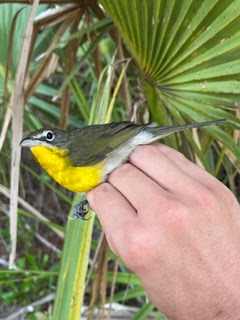CAPTAIN SAMS
Today was another exciting day out at Captain Sams as morning winds brought a short rush of birds during our first net run. We caught a total of 39 birds, which consisted of 33 new birds and 6 recaptures! Most of our captures today were during our first nest run, which gave us a little taste of what is to come in the near future.
One of the more exciting captures for the crew today was our first yellow-breasted chat of the season. Chats are unique as they are the sole member of the family Icteriidae, but were once considered by Ornithologists to be a warbler of some kind. Although once considered to be warblers, they are quite sizable in comparison and sport an exceptionally large, chunky bill. During the breeding season, it is possible to observe male chats performing flight displays to attract females. This can be quite spectacular to watch, as they otherwise are often quite skulky in nature. For banders, catching young yellow-breasted chats can provide a great opportunity to observe an interesting molt strategy. Before we get into the details of what this strategy is I thought it would be useful to discuss the two types of feathers we typically see in most young birds and why they are important to the survival and livelihood of these birds during their first year of life!
When young birds leave the nest for the first time they are equipped with entirely juvenal feathers that were grown in the nest. These feathers tend to be grown at a rapid pace in order to help young birds fledge as quickly as possible! The reason for this is that young birds in the nest are extremely vulnerable to predators, as they cannot fly on their own to escape what could be a life or death situation. The faster they can get out of the nest and become mobile the better! The cost of growing feathers so quickly at such a young stage of life is that they often are structurally weak, especially in comparison to adult birds.
In order to improve chances of survivorship, young birds often replace some of these juvenal feathers with newer, stronger feathers. These new feathers are often referred to by Ornithologists as formative feathers. Although most young birds will only replace a few important feather groups with formative feathers, some will go above and beyond and replace even more. An example of this are birds that undergo what we call an eccentric molt, which yellow-breasted chats often do! An eccentric molt is when a young bird replaces the outermost primary flight feathers and the innermost secondary flight feathers, which can be seen in the image below. This often leaves a somewhat awkward chunk of old, juvenal flight feathers in between what are newly replaced formative feathers on the wing. For bird banders, this is always a fun and exciting molt strategy to observe and is not typical of most songbirds we see on a day to day basis.
A great example of eccentric molt seen in our yellow-breasted chat we caught today! Although somewhat difficult to see the juvenal feathers (red) are shorter and browner in coloration compared to the newly grown in formative (white) feathers. The formative feathers are somewhat longer and are much darker, especially noticeable on the shaft.
Yellow-breasted Chat (hatch year, unknown sex)
LITTLE BEAR
Braving humidity, heat, and hordes of mosquitos we managed to head out to Little Bear and set up 14 of the 26 nets that will be in operation this season. We are so excited to get things going at this site and are hoping to have it up and running by the end of the week sometime!
-Noah Nei
Note: All banding, marking, and sampling is being conducted under a federally authorized Bird Banding Permit issued by the U.S. Geological Survey’s BBL
| Species | Captain Sams | Little Bear | ||
|---|---|---|---|---|
| New | Recaps | New | Recaps | |
Red Eyed Vireo | 5 | - | - | - |
Blue-gray Gnatcatcher | 1 | - | - | - |
Northern Waterthrush | 6 | - | - | - |
Yellow-breasted Chat | 1 | - | - | - |
Black-and-white Warbler | 4 | - | - | - |
Prothonotary Warbler | 3 | - | - | - |
American Redstart | 6 | - | - | - |
Yellow Warbler | 3 | - | - | - |
Prairie Warbler | 3 | - | - | - |
Painted Bunting | 1 | 4 | - | - |
Northern Cardinal | - | 2 | - | - |
| Today's Banding Stats | Captain Sams | Little Bear | TOTAL |
|---|---|---|---|
| # Birds Banded | 33 | - | 33 |
| # of Recaptures | 6 | - | 6 |
| # of Species | 11 | - | 11 |
| Effort (net-hours) | 139.7 | - | 139.7 |
| Capture Rate (birds/100 net-hours) | 27.9 | - | 27.9 |
| # of Nets | 32 | - | 32 |
| 2024 Fall Cumulative Banding Stats | Captain Sams | Little Bear | TOTAL |
|---|---|---|---|
| # Birds Banded | 142 | - | 142 |
| # of Recaptures | 55 | - | 55 |
| # of Species | 23 | - | 23 |
| Effort (net-hours) | 917.3 | - | 917.3 |
| Capture Rate (birds/100 net-hours) | 21.5 | - | 21.5 |
| # of Days | 6 | - | 6 |
Banding Staff
Aaron GivenMichael Gamble
Kristin Attinger (CS)
Natalie Miller (CS)
Lisa Viviano (CS)
Noah Nei (CS)



No comments:
Post a Comment